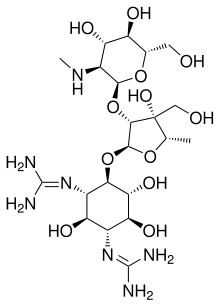Dihydrostreptomycin
Dihydrostreptomycin is a derivative of streptomycin that has a bactericidal properties.[1] It is a semisynthetic aminoglycoside antibiotic used in the treatment of tuberculosis.[2]
 | |
| Clinical data | |
|---|---|
| AHFS/Drugs.com | International Drug Names |
| ATC code | |
| Identifiers | |
IUPAC name
| |
| CAS Number | |
| PubChem CID | |
| ChemSpider | |
| UNII | |
| ChEMBL | |
| CompTox Dashboard (EPA) | |
| ECHA InfoCard | 100.004.445 |
| Chemical and physical data | |
| Formula | C21H41N7O12 |
| Molar mass | 583.59 g/mol g·mol−1 |
| 3D model (JSmol) | |
SMILES
| |
InChI
| |
| (verify) | |
It acts by irreversibly binding the S12 protein in the bacterial 30S ribosomal subunit, after being actively transported across the cell membrane, which interferes with the initiation complex between the mRNA and the bacterial ribosome. This leads to the synthesis of defective non-functional proteins, which results in the bacterial cell's death.[1]
It causes ototoxicity,[3] which is why it is no longer used in humans.
See also
- Streptomycin
- Translation (biology)
References
- "Dihydrostreptomycin (Code C61724) - NCI Thesaurus". Retrieved July 7, 2016.
- "Dihydrostreptomycin Sulfate - MeSH - NCBI". Retrieved July 7, 2016.
- Harrison, Wiley H. (1954). "Ototoxicity of dihydrostreptomycin". Quarterly bulletin. Northwestern University (Evanston, Ill.). Medical School. 28 (3): 271–3. PMC 3803976. PMID 13186082.
This article is issued from
Wikipedia.
The text is licensed under Creative
Commons - Attribution - Sharealike.
Additional terms may apply for the media files.